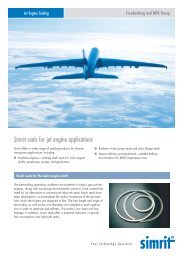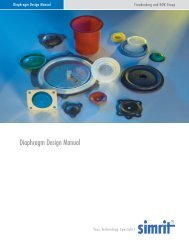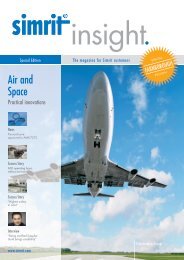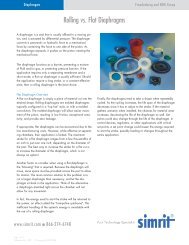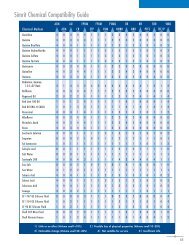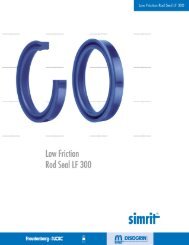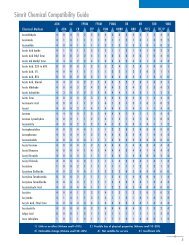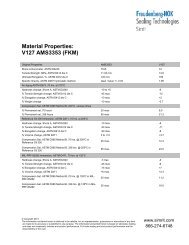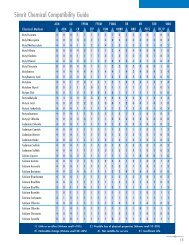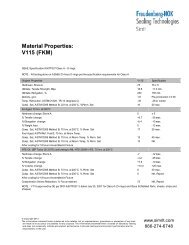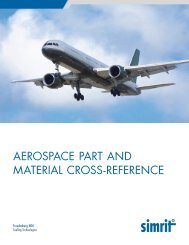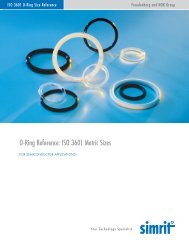Plate Seals Brochure - Simrit
Plate Seals Brochure - Simrit
Plate Seals Brochure - Simrit
You also want an ePaper? Increase the reach of your titles
YUMPU automatically turns print PDFs into web optimized ePapers that Google loves.
Groove-Bonded <strong>Plate</strong> <strong>Seals</strong><br />
The groove-bonded plate seal design is optimized to<br />
take full advantage of the sealing capabilities of the<br />
elastomer. The elastomer is<br />
completely contained in the<br />
groove, and the squeeze<br />
and the volume/void ratio<br />
are optimized for each<br />
elastomer type and<br />
application condition.<br />
Groove-bonded seals are bi-directional seals and offer<br />
extra protection to the elastomer in highly corrosive<br />
environments. They provide superior extrusion resistance<br />
in high pressure applications.<br />
Typical Applications for Groove-Bonded <strong>Plate</strong> <strong>Seals</strong>:<br />
Bi-directional applications<br />
Extreme pressure applications<br />
Lower volume applications with metal retainers<br />
Higher volume applications with plastic retainers<br />
Edge-Bonded <strong>Plate</strong> <strong>Seals</strong><br />
The edge-bonded plate seal retains many of the advantages<br />
of groove bonded plate seals, such as controlled<br />
squeeze and metal-to-metal<br />
contact. The main advantage<br />
of the edge bonded<br />
design is the ability to stamp<br />
the metal retainers, which<br />
reduces the manufacturing<br />
cost for high-volume applications.<br />
Edge-bonded seals are typically uni-directional<br />
seals, with the elastomer on the high pressure side and<br />
the retainer on the lower pressure side.<br />
The retainer onto which the seal is molded may be any<br />
metal and even some composite materials. The sealing<br />
element can consist of virtually any elastomeric compound,<br />
including Simriz ® perfluoroelastomer (FFKM), for the most<br />
extreme environments, and even polyurethane.<br />
Typical Applications for Edge-Bonded (EPB) <strong>Plate</strong> <strong>Seals</strong>:<br />
Uni-directional applications<br />
High volume applications<br />
Less-critical performance requirements<br />
Incorporates all sealing fundamentals for lower cost<br />
Compared to O-rings, die-cut seals, and cure-in-place seals,<br />
edge-bonded plate seals offer superior performance in<br />
these fundamental areas:* controlled squeeze, resilience,<br />
alternate load path, confinement, and volume-to-void ratio.<br />
*where space limitations prevent use of a groove-bonded design.<br />
Edge-Bonded <strong>Plate</strong> Seal<br />
Variation: Step with optional<br />
cross-holes increases the<br />
bonding area and adds a<br />
mechanical locking feature<br />
to seal resilience. The plate<br />
retainer thickness can be<br />
reduced considerably.<br />
The Freudenberg-NOK organization draws from<br />
more than 150 years of experience and offers quality,<br />
well-known brand names including Freudenberg ® ,<br />
NOK ® , International Seal ® , Simriz ® , Disogrin ® , and<br />
Merkel. Call <strong>Simrit</strong> today at 1-866-274-6748 to find<br />
out how our total sealing solutions can benefit you.<br />
Or visit www.simrit.com.<br />
2



